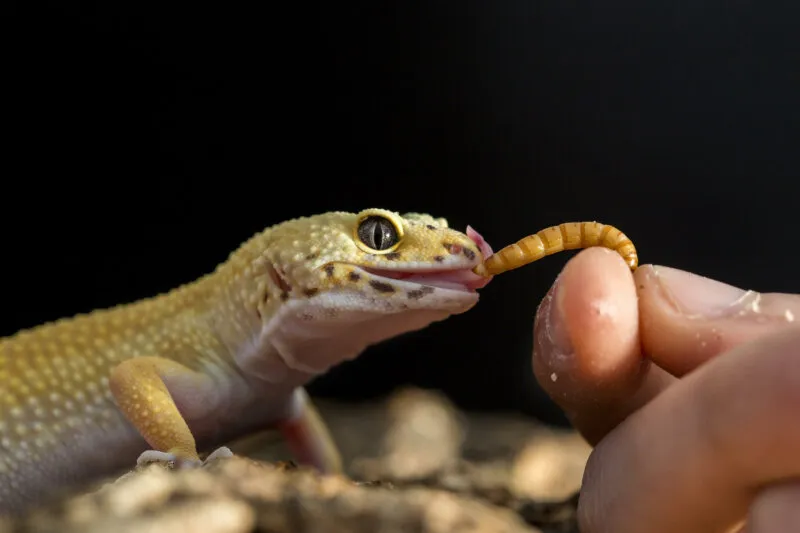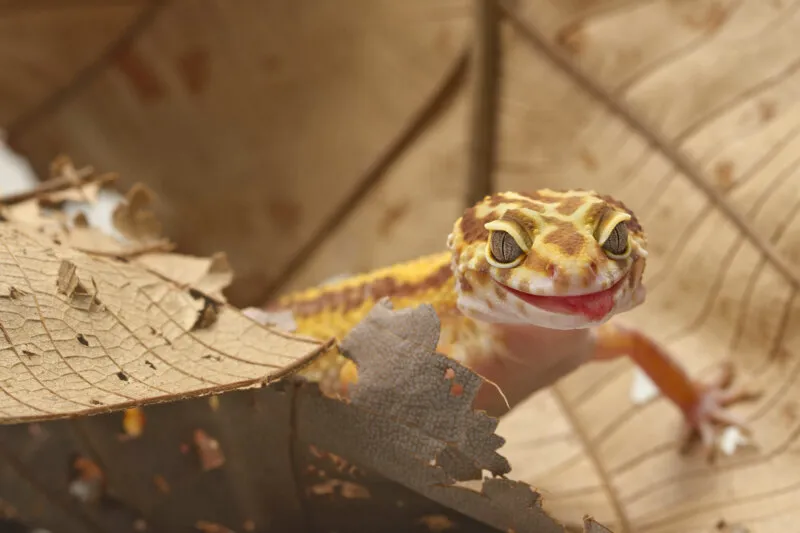
Mealworms are a popular
Mealworms can be an impaction risk for leopard geckos if:
- They are fed in too great of quantities
- Too large of individual mealworms are fed
- Substrate is ingested during feeding
- Mealworms are fed when they have a hard, tan-colored shell
Here’s what you need to know about how, when, and in what quantity to feed mealworms to your leopard gecko in order to avoid an impaction risk.
Table of Contents
Can Feeding Mealworms to Leopard Geckos Cause Impaction?
Most leopard geckos absolutely love eating mealworms, and when fed correctly as part of a balanced diet, mealworms can be beneficial to your leopard gecko.
However, under some circumstances, mealworms can also lead to the dreaded condition known as impaction. Here are some of the reasons why feeding mealworms to your leopard gecko can lead to impaction.
Mealworms Have Hard Shells Which can be an Impaction Risk
Mealworms are actually the larval stage of a hard-shelled beetle known as Tenebrio Molitor, which is a type of darkling beetle. After the beetle lays its eggs, the eggs hatch into the larval stage which we know as mealworms.
They then turn into a pupa and eventually into an adult beetle.
During the larval stage, mealworms develop a hard shell that helps protect them in their subterranean environment. They may shed as many as 10 to 14 times before they eventually go into their pupil form.
There are some times during the life of a mealworm when it is better to feed to your leopard gecko than others. When a mealworm first sheds, they are white or cream in color and their shell is noticeably softer to the touch.
During this time, they are much less likely to cause impaction for your leopard gecko than when their shell is tan or yellow and harder to the touch.
When a mealworm first goes into the pupil stage it is also a creamy white color and safe to feed to your leopard gecko.
While it may still be possible for your leopard gecko to become impacted from eating a mealworm during this stage, it is much less likely.

Leopard Geckos can Consume Substrate When They Consume Mealworms, Leading to Impaction
Leopard geckos eat by extending their tongue and drawing
This may be more likely with a species that burrows, like mealworms, than it would be for a species that tends to climb, like crickets.
Consuming substrate can be a serious impaction risk for your leopard gecko. This is especially true if your substrate is composed of something that poses a significant impaction risk, like sand.
Still, usually, leopard geckos are okay with digesting a little bit of substrate. Problems start if they swallow too much or if it is combined with a hard-to-digest diet.
Impaction can be Caused if Leopard Geckos Can Eat Mealworms That are Too Big
Sometimes, a leopard gecko’s eyes are bigger than its stomach, especially when it comes to a delectable treat like mealworms.
Since mealworms are one of the highest value foods that you are likely to offer your leopard gecko, your gecko may be more likely to consume an individual worm that is too big for them than they are with other types of
Mealworms grow quickly at room temperature, which means that the mealworms you bought at the store a week ago may be too large for your leopard gecko now. If your leopard gecko eats a mealworm that is oversized, impaction is much more likely.
Mealworms can Cause Impaction in Leopard Geckos Due to Overfeeding
Impaction can be caused when leopard geckos are overfed, resulting in obesity. Mealworms can be a significant contributing cause of obesity since they are very attractive to leopard geckos and also quite high in fat.
A diet high in mealworms can lead to an obese leopard gecko, which in turn can make constipation and impaction more likely.
Mealworms should never compose the bulk of your leopard gecko’s diet. They must be fed in moderation along with other, less fattening meal choices like crickets.
This leopard gecko is clearly enjoying its mealworms, but this is a bigger offering of mealworms than is advisable, and these mealworms haven’t recently shed:
How to Safely Feed Mealworms to Your Leopard Gecko
White is Alright When it Comes to Feeding Mealworms to Your Leopard Gecko
Since mealworms go through a life cycle when their shell is sometimes harder and sometimes softer, choosing to only feed mealworms that have a softer shell can dramatically reduce the risk of impaction.
By simply selecting your feeding mealworms when they have first shed or turned into pupa, you can significantly reduce the risk that your leopard gecko will be impacted.
Mealworms shed quite frequently, so you have lots of opportunities to choose a recently shed individual.
Breeding mealworms yourself or purchasing them when they are quite small gives you more time to choose freshly shed individuals to feed your leopard gecko.
Keep in mind that if mealworms get away and have an opportunity to grow a hard shell, impaction risks will go up.
Therefore, it’s wise to feed mealworms from a bowl and carefully monitor to make sure that your leopard gecko eats all of them while the shell is still soft.
Feed Mealworms From a Bowl or Choose a Substrate That Won’t be Ingested
Mealworms are one of the more convenient things to feed your leopard gecko, in part, because they can be quite easy to confine to a shallow bowl.
As long as the sides are slick enough that the mealworm can’t get a grip, they will stay in the bowl where your leopard gecko can safely eat them without any risk of eating the substrate along with them.
This is also a good idea since a mealworm put into your leopard gecko’s enclosure will quickly seek out shadowy places underneath decor where your leopard gecko won’t be able to get to them.
If you’d rather have your leopard gecko work a bit harder for their

Choose the Right Sized Mealworm for Your Leopard Gecko
Large mealworms are a significantly higher risk than smaller ones. Your leopard gecko should easily be able to pick up and swallow mealworms without having to struggle to position it. If in doubt, err on the side of caution.
While you can save money by waiting until mealworms get bigger to feed to your leopard gecko, you take a significant risk that the mealworm will be too big, so be careful and stick with only very small mealworms for your leopard gecko to consume.
Refrigerating your mealworms will slow down their life cycle and can give you more time with mealworms at the ideal size for feeding to your leopard gecko.
Feed Mealworms in Moderation
Leopard geckos love to eat mealworms. If it was up to your leopard gecko, they would probably consume as many as they possibly could. However, feeding your leopard gecko too many mealworms can lead to obesity, which makes constipation and impaction more likely.
Therefore, mealworms should only compose a small portion of your leopard gecko’s diet. It is best to only give your leopard gecko one or two mealworms at a time, and provide them as a treat, whereas the bulk of the diet should be composed of healthier insects like crickets.
Can Feeding Mealworm Beetles Lead to Impaction?
Darkling beetles, the adult stage of mealworms, should never be fed to your leopard gecko. Beatles have very hard shells, much harder even than the shell of a mealworm that is preparing to shed, and they pose a significant impaction risk to your leopard gecko.
While it can be tempting to save money by feeding any mealworms that have turned into beetles to your gecko, this is never a good idea.
Mealworms vs Superworms – Which is less likely to lead to impaction?
We’ve established the risks that mealworms can cause, but what about the similar
In fact, they are typically as much as five times bigger than a mealworm. They also tend to have thicker shells.
If you choose young superworms that are still quite small and only feed them right after they have shed, they should pose no more risk of impaction than a mealworm would cause.
However, a superworm that is close to turning into a puba and has not recently shed can be a serious impaction risk.
These worms are too large for even the biggest of leopard geckos and their shells will be thick enough to be a serious risk. The pupa of a a superworm is also likely too big to be a good option for feeding your leopard gecko.

Does What a Mealworm Eats Increase Risk of Impaction for Your Leopard Gecko?
Feeding your mealworm and any other feeder insects a quality diet is always a very good idea. After all, the healthier your mealworm’s diet, the more nutritionally dense the mealworm will be.
In general, it is very unlikely that your mealworm’s diet will affect the chances of the mealworm causing impaction in your leopard gecko.
However, a very high fiber diet may slightly increase the chances of the mealworm also being very high in fiber and making impaction more likely.
A balanced diet for your mealworm is a good idea. Offer them dog or cat
Mealworms can eat just about anything, so it can be easy to settle into a simple diet of grains along with a source of moisture.
However, diversifying your mealworm’s diet means that there is more moisture and less fiber in the mealworm, which can result in a reduced chance of impaction.
While mealworms will eat non-food items like plastic and styrofoam, they should never be given access to these foods, as having styrofoam or plastic in their gut can make it much more likely that impaction will be an issue if your leopard gecko consumes these mealworms.
Can Breeding Your Own Mealworms Reduce the Risk of Impaction?
In theory, there should be no higher risk in store-bought mealworms than in mealworms you breed yourself. However, in practice, people who breed their own mealworms may find that the risk of impaction for their leopard geckos is reduced.
This is because if you are not breeding your own mealworms, when your mealworms become too big or turn into beetles, you have lost money in the investment you made in purchasing the mealworms in the first place.
You can refrigerate your mealworms to slow down their life cycle and keep them at the correct size for longer, but when you are trying to select for mealworms that have recently shed of the appropriate size for your leopard gecko, the chances of you being able to use up all of your store-bought mealworms is significantly reduced.

On the other hand, if you breed your own mealworms, any individuals that get too big or turn into beetles just become a part of your breeding population, rather than going to waste.
This makes it much less likely that you’ll be tempted to feed a mealworm that is too big or that has not recently shed.
Avoid Mealworm Related Impaction in Your Leopard Gecko
Mealworms can be a delicious part of your leopard gecko’s diet when fed properly. Be careful to only feed mealworms at the right time and in the right amount and you will likely find that your leopard gecko does not have problems with impaction as a result of mealworms in their diet.
- Enchi Ball Python: A Unique and Stunning Morph of Python regius - March 27, 2025
- Emerald Tree Monitor: The Enigmatic Green Guardian of the Rainforest - March 26, 2025
- The Egyptian Cobra (Naja haje): A Fascinating Serpent - March 25, 2025
